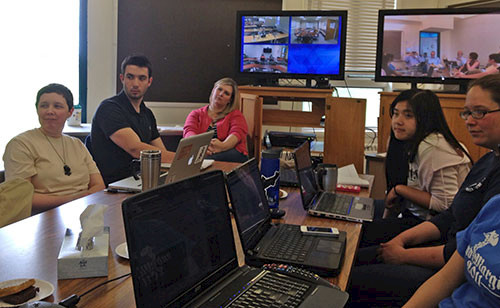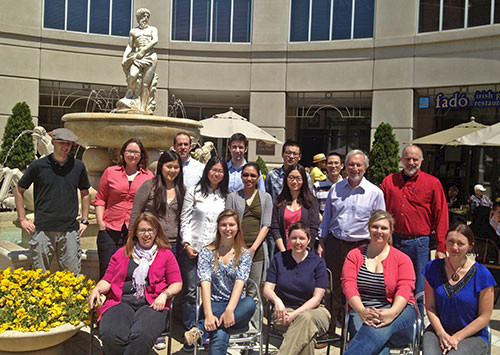Teaching with a ‘flipped classroom’ over an interactive video network
Bill Dennison ·Don Boesch and I just completed teaching a course in Science for Environmental Management as part of the Marine-Estuarine-Environmental Sciences graduate program. This course was taught using an inverted or ‘flipped’ classroom style for the first time. Don and I posted the readings as pdfs and the lectures as 10-15 min. Quicktime or YouTube videos ahead of the classtime. The students watched the videos and read the materials ahead of class so that we could have an informed discussion during classtime. As a result of the freed up classtime, we were able to invite a variety of topically relevant guests, which enriched the discussion.
The MEES program is a multi-institutional, multi-campus program which relies heavily on an interactive video network (IVN) system with real time full audio-video connectivity between campuses. We were able to use the flipped classroom approach with the IVN system and have the discussion across the different remote sites. The other thing that the IVN system did was provide us an opportunity to capitalize on the proximity of many of our guests to our University of Maryland Center for Environmental Science Annapolis Office, adjacent to the National Socio-Environmental Synthesis Center.

Laboratory and using the Interactive Video Network, at Chesapeake
Biological Laboratory, Institute of Marine and Environmental
When we discussed Chesapeake Bay, our guest was Nick DiPasquale, Director of the Chesapeake Bay Program. When we discussed climate change, David Costello, Deputy Secretary of Maryland Department of the Environment, who is leading the climate mitigation efforts joined us. When we discussed various case studies across size and population gradients, we had a serious of relevant experts, including the Chester Riverkeeper, David Foster, Jane Thomas from IAN to talk about the Palau case study, Simon Costanzo from IAN to talk about the Moreton Bay case study. When we discussed science in the media, Tim Wheeler, the environmental reporter from the Baltimore Sun and Amy Pelsinsky, the media relations director from UMCES joined us. When we discussed fisheries issues, Ed Houde from UMCES and Tom O’Connell, Director of the Department of Natural Resources Fisheries. Dr. Bob Summers, Maryland Secretary of Environment, joined us to talk about using science in environmental management. When we discussed science ethics, we had Dr. Robert Twilley from Louisiana State University talk to us about working as a state science advisor. We discussed environmental report cards with Dr. Heath Kelsey and Caroline Wicks from EcoCheck who produce the Chesapeake Bay report card, as well as various other report cards around the world.
The flipped classroom provided several enhancements for teaching. 1) The short pre-recorded lectures were more succinct and focused than a single, longer lecture. I found that the act of preparing and recording short lectures created a more thoughtful and cohesive message. 2) The opportunity to more fully interact with students about the lectures and readings led to a more reflective and analytical discussion than typically occurs in the short question/answer sessions following the typical 45 min lectures. 3) The discussions and feedback from students during classtime throughout the semester led to several mid-course adjustments in the course syllabus, with new topics, readings and guests added to accommodate student interests and requests. 4) The flipped classtime provided more opportunities to invite various guests, which expanded the exposure of students to different viewpoints. 5) The blog posts that students produced to capture and interpret the classtime discussions were very interesting to read each week. I found myself eagerly awaiting their thoughtful and creative blogs each week.
One of the things that we found to be important was to have a couple of in person sessions to have all of the students and instructors in the same room. Since we had students from a variety of Maryland locations, we chose to meet in Annapolis as a central location. We met in the UMCES Annapolis Office on two Saturdays, once to learn about science communication using a hands on training session and then once to conduct a mini-symposium for students to present their project reports. The in person sessions were important to enhance the Interactive Video Sessions—the in person sessions helped break the ice and served to encourage questions and interactions over the video network.

About the author
Bill Dennison

Dr. Bill Dennison is a Professor of Marine Science and Vice President for Science Application at the University of Maryland Center for Environmental Science.

